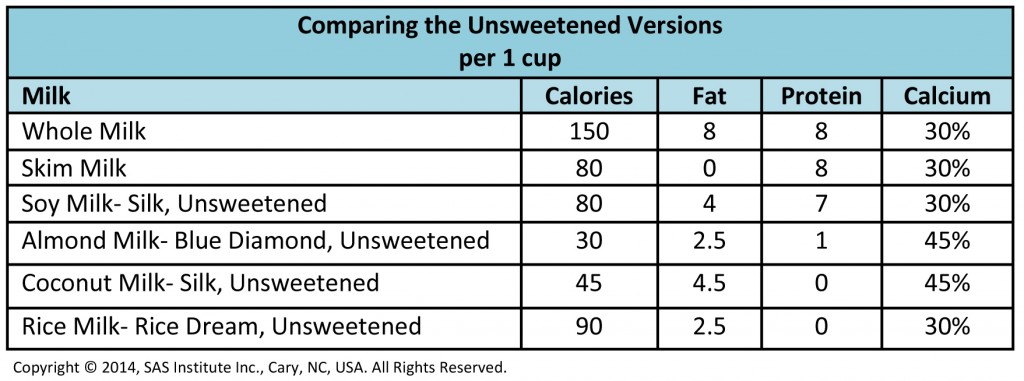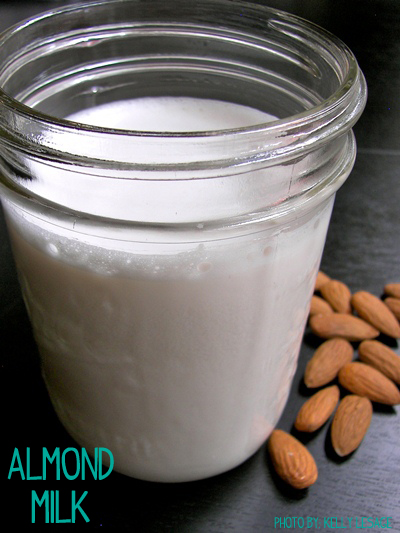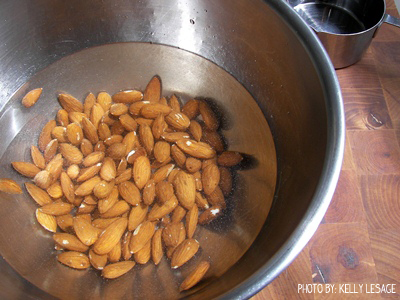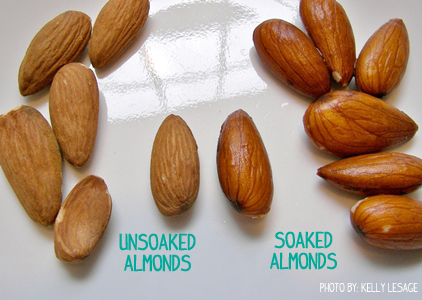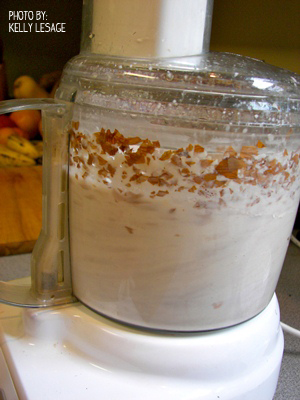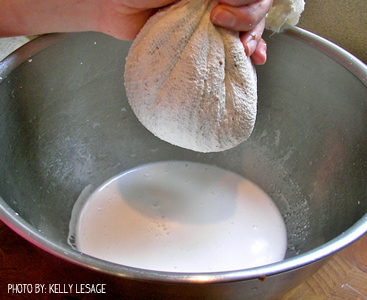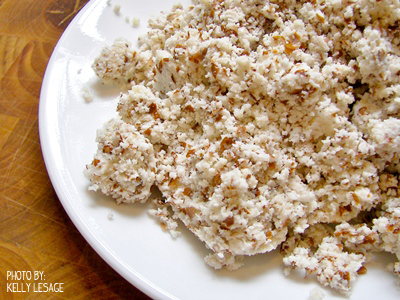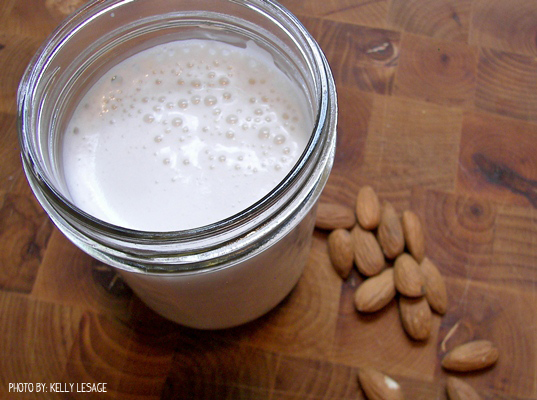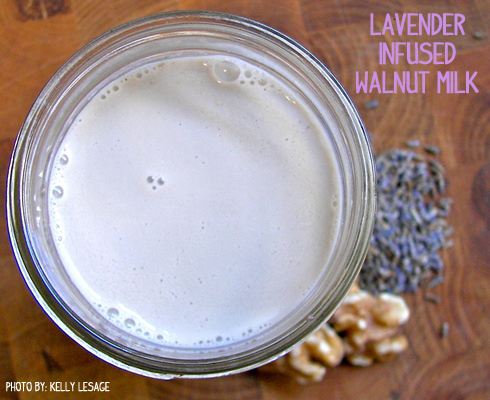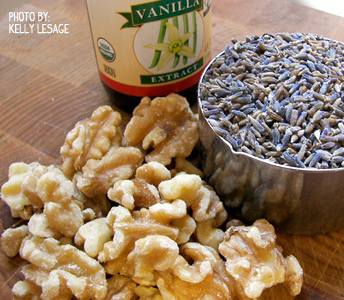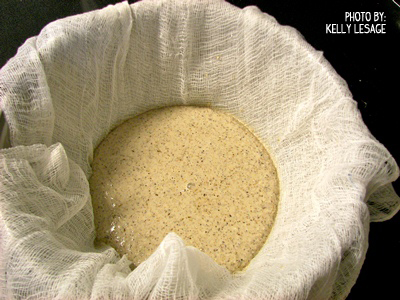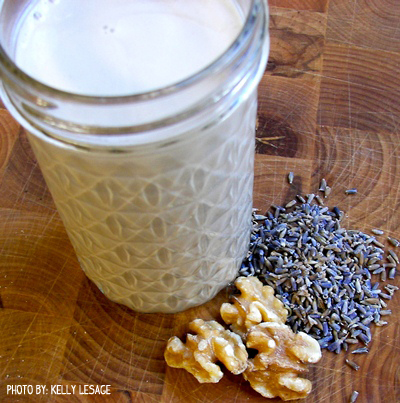This is a question I get pretty often. It’s not an easy question to answer either. It depends on what your goal is. Do you want a milk that’s low in calories or do you want one that’s high in protein? Maybe taste is your only criteria. Luckily, if you can’t or don’t want to drink cow’s milk there are many options in the grocery store these days.
The most common nondairy milks are soy, coconut, almond and rice. But if you peruse the aisles at stores like Whole Foods you will also find hemp milk, oat milk, flax seed milk, cashew milk, and a few others.
Most of the nondairy milks have added vitamins and minerals to mimic what would be in cow’s milk. Most add calcium and vitamin D; some add other vitamins too.
Let’s take a closer look at the most common ones:
Soy Milk
- Mild "beany" flavor
- 80-120 calories per cup
- Typically 5-8g protein per cup
- Read THIS blog for info on the controversies of soy
Coconut Milk
- Mild coconut flavor
- 45-90 calories per cup
- No protein
- Not the same as the canned coconut milks
Almond Milk
- Typically a mild nutty flavor
- Many people prefer this nondairy milk (taste wise)
- 30-100 calories per cup
- Very little protein (most around 1 g per cup)
Rice Milk
- Mild flavor
- Some brands can be gritty
- 90-160 calories per cup
- No protein
Many of the nondairy milks have added sugar. If you are trying to reduce your sugar intake make sure to buy one that is unsweetened. Almost all of them have some kind of thickener and some have preservatives as well. Carrageenan is one thickener that is in many "natural" foods. Some studies implicate carrageenan in certain digestive diseases and inflammation, but other studies show no adverse effects.
One thing to keep in mind is that most nondairy milks are highly processed; loaded with sugars, preservatives and artificial ingredients to enhance flavor and extend shelf life; and not exactly a whole, real food. If you want to try some of these, at least shop in the refrigerated section; these milks will typically have fewer preservatives than the shelf stable options. Pay attention to the ingredients! If it’s loaded with things you can’t pronounce, then its best to just put it back on the shelf.
Making your own nondairy milk is actually pretty easy, and I think they taste much better than the stuff on the shelves. Also, YOU control what goes in and what doesn’t go in (sugar, thickeners, preservatives, etc.).
Almond milk is a great one to start with. You can follow this same method with most any raw nut.
Almond Milk
Ingredients
1 cup raw almonds
3 ½ cups water (more if you want it thinner and less if you want it thicker)
Cheesecloth or a nut milk bag
Directions
1. In a large bowl, combine almonds with enough water to cover by a few inches. Cover and let sit in the refrigerator overnight or up to 2 days (the longer they soak, the better the almond milk).
2. You will see that the almonds plump up!
3. Rinse and drain almonds, then place in blender or food processor with 3 ½ cups of water. Blend on low and work up to high speed for at least 1 to 2 minutes. If you are using a food processor, blend on high for 4 minutes, scraping down the sides halfway through.
4. Line another bowl with the cheese cloth and pour pureed almond mixture over the cheese cloth.
5. Gather on all corners to form a "bag" and start squeezing.
6. Continue to wring and squeeze until all the liquid is out and you are left with dry almond pulp.
7. Pour the almond milk into a glass container (with tight fitting lid) and refrigerate. You will want to use the almond milk within 3 days.
Tips:
- If you don’t have a very powerful blender, add just a little water to start with and then once the almonds are blended add in the rest.
- You can add vanilla, cinnamon or other flavorings. You can also sweeten the almond milk if you want to by adding honey, maple syrup or even dates while it’s in the blender.
- You can use cheesecloth, muslin, swiss voile or special nut milk bags to filter out the pulp.
Nutrition Content: the nutrition content is hard to determine since it will depend on how much water you use, how much pulp is strained out, etc. This recipe, using 3-4 cups of water, will be about 40 calories , 4g total fat, 0g saturated fat, 0mg cholesterol, 5mg sodium, 1g carbohydrate (1g dietary fiber, 0g sugar), and 1g protein per cup.
What to do with the pulp? Don’t toss it!!!
- Use it to make crackers like THESE or THESE
- Stir 1-2 Tablespoons into oatmeal or add to a smoothie
- Dehydrate into almond meal (and use in recipes like THIS)
For a slightly more luxurious milk try...
Lavender Infused Walnut Milk
Recipe adapted from Mountain Rose Herbs
Ingredients
1 cup raw walnuts
½ cup lavender flowers
1 teaspoon vanilla extract
2-4 cups water (depending on how thick you want it)
Honey or maple syrup to sweeten (optional)
Directions
1. Soak walnuts in water overnight. Strain and rinse well. Place walnuts in food processor or blender with 2-4 cups water, lavender, and vanilla. Blend. While the food processor is running, drizzle in a little honey or maple syrup.
2. Line a bowl with cheesecloth and pour pureed mixture into bowl. Strain off as much liquid as possible and save your lavender walnut pulp!
3. You can store the walnut pulp in the fridge and use in oatmeal, smoothies, cookies, or recipes like THIS! Yum! Your walnut milk should keep in the fridge for about one week, the fresher the better!
Nutrition Content: nutrition content is hard to determine since it will depend on various factors such as water content, added sweetener, amount of pulp left in or strained out, etc.
Click here for a printer-friendly version of these recipes.
Click here for a printer-friendly version of this blog post.
